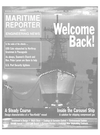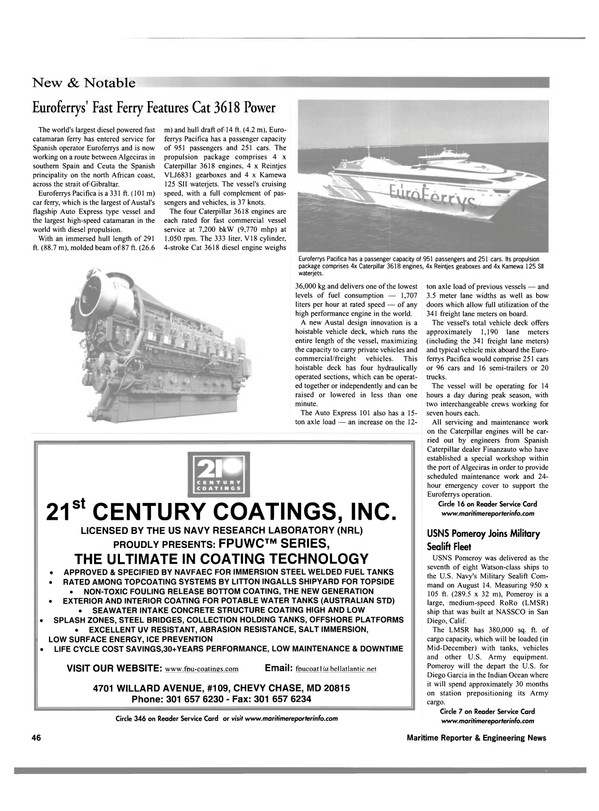
Pumping Ballast for Ocean-Going Barges
In Seattle, Wash., two of the largest barge companies in the world use Bibo pumps from ITT's Flygt unit and axial flow pumps from ITT's Goulds Pump unit to pump ballast water for trim and balance of oceangoing barges as they load and unload their cargo of commodities.
One of the regions of the world with a large concentration of tugs and barges is the Pacific Northwest of the U.S., particularly around the City of Seattle.
Headquartered in Seattle, Foss Maritime operates the largest tug fleet on the west coast and provides a full range of marine transportation services. The cargo for Foss' barges is diverse and includes weekly scheduled tows transport agricultural products such as peas, beans, lentils, flour, hay cubes, alfalfa products, as well as milk carton stock and dimensional lumber, from the ports of Lewiston, Umatilla, and Portland, for export overseas.
Refrigerated containers laden with french fries and other perishable commodities are shipped in special barges outfitted with generators.
A 286-ft. (87.1-m) ocean-going cargo barge was recently transferred from Foss Maritime to a sister company, Hawaiian Tug and Barge. Designed to transport cargo in 20 x 8 x 8-ft. (6 x 2.4 x 2.4-m) containers that are stacked on the deck of this huge barge, the barge underwent a large-scale modification at the Foss shipyard in Seattle for work in the Hawaiian islands. One of the most important modifications was the addition of a new pump scheme to simplify the ballasting system aboard the barge.
As the barge is loaded and unloaded with the massive containers that are often driven on and off the barge, the barge must stay even with the dock. When loading the containers, this means adjusting the ballast by pumping sea water out of the ballast tanks to increase the buoyancy of the barge — with the reverse being the case as cargo is offloaded; a procedure requires great communication between the barge operator and the longshoremen.
The existing labor-intensive, antiquated ballast systems on most barges usually use big, inefficient pumps, thousands of feet of expensive alloy piping, manual labor to turn valves, and lots of room for error.
As part of the modification of the barge, Foss Maritime requested that a Goulds Pump distributor, Beckwith & Kufifel help them re-evaluate the way operators ballast/ de-ballast the barge.
According to Mark Romero of Beckwith & Kuffel, "The barge in question required four ballast systems. The goal when ballasting/de-ballasting is to trim and balance the barge as it is loaded and unloaded with ocean containers." Romero continued, noting that, "The advantage of the axial flow pump is that it can run in both directions — for ballast and deballast.
This unique feature and benefit allowed us to solve their problem." Romero contacted Charlie Burrows of Goulds Pumps Ashland Operations, for assistance. Together, Romero and Burrows concluded that a Goulds axial flow pump, which can run in alternating rotation, could provide a simplified solution to a complex operation. Running the pump in standard rotation would add ballast.
Reversing rotation would send water out the sea chest.
This solution resulted in the installation of four Alloy 20 MPAF pumps, including motors, control panels, and variable frequency drives. The reverse-rotation approach has greatly simplified adjusting the barge ballast. The Goulds solution has also reduced the alloy piping requirements and minimized the number of expensive valves that are required, and made changing the barge ballast simpler and faster. Now a simple push of a button will change ballast in minutes instead of hours.
Foss Maritime has found this innovative system greatly beneficial, as it reduces the company's total cost of ownership — initial price, energy consumption, maintenance and operation costs are all dramatically reduced.
Circle 2 8 on Reader Service Card
Read Pumping Ballast for Ocean-Going Barges in Pdf, Flash or Html5 edition of October 2001 Maritime Reporter
Other stories from October 2001 issue
Content
- Gratingless Air Circ System in Reefer Ships page: 44A
- New Technology To Debut At Europort page: 44B
- AIS: T h e Future is N ow page: 44F
- NOL Reports First Half Profit of $1M page: 4
- Speechless page: 6
- John Deere Offers N ew 3 0 0 HP Engine page: 7
- Now the Carousel Ship page: 8
- Port Security Strengthened in Wake of Disaster page: 12
- A Race With A Meaning ... Before the Fall of the Towers page: 14
- SCI: Disaster Relief on the Fly page: 15
- Following Wake of Terrorist Attacks, USS Cole is Relaunched page: 18
- INTERTANKO Offers Support, Vital Information During National Tragedy page: 19
- G O M Softness Drives GLM Score Down page: 20
- All-Purpose Aid And Hospital Vessel Delivered page: 21
- ASRY's Services Are In High Demand page: 23
- Rolf To The Rescue: German Yard Delivers Aluminum Rescue Launch page: 25
- Fusion Polycraft's RIB Designed To Be Indestructible page: 25
- Sea-Kindly: A Steady Vessel by Design page: 26
- New Inland Containership Concept Unveiled page: 30
- High-Tech Service Initiatives From Deltamarin page: 32
- FORAN v50: A Technological Renovation page: 36
- N a p a O y Opens Office In Japan page: 38
- NUPAS-Cadmatic Offers V4.3 page: 40
- Ship Evac Simulation Software Shows Promise page: 42
- Wartsila s Dual-Fuel Engine Power Module For FPSO Upgrade page: 44
- Euroferrys' Fast Ferry Features Cat 3618 Power page: 46
- PRI Fuel Treatment Helps Meet Emissions Challeng es page: 47
- Western Towboat Gets A N e w Titan page: 48
- Nichols Bros. To Construct Powerful Fireboat page: 50
- Statoil Ships Run on Gas... Liquefied Natural Gas That Is page: 51
- W Q I S Broadens Coverage To Meet State Requirements page: 52
- Wartsila Wins Environmental Award page: 53
- Pumping Ballast for Ocean-Going Barges page: 54
- Self-Cleaning Filter System Cuts Maintenance Costs page: 60
- CMP Packs Decade of Tin-Free Experience page: 62
- MarineLine Boosts C l e a r w a t e r ' s Profitability page: 64
- Dampney Manufactures Advanced Coatings page: 67
- W a r t s i l a Engines To Power Queen M a r y 2 page: 70
- Keppel Hitachi Zosen Delivers Semi-tender Rig page: 73


